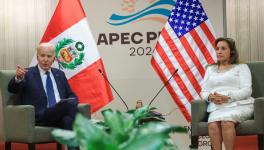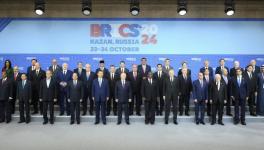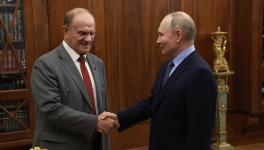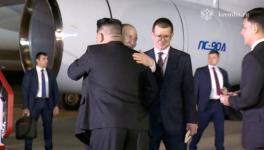US Rolls Out New Central Asia Strategy
US Secretary of State Mike Pompeo (3rd L) and counterparts from Central Asian states in the C5+1 format, Tashkent, February 3, 2020
Every five to six years, roughly, the United States comes out with a ‘new’ Central Asia strategy. The Indian automobile industry might call it “facelift” — cosmetic changes to create an air of novelty, such as a new radiator grill, a tweak in the rear bumper, exciting colour options and so on.
The document titled United States Strategy for Central Asia 2019-2025, which was released by the US State Department on February 5, keeps up the tradition.
The document says in its Foreword, “The United States’ primary strategic interest in this region is to build a more stable and prosperous Central Asia that is free to pursue political, economic, and security interests with a variety of partners on its own terms; is connected to global markets and open to international investment; and has strong, democratic institutions, rule of law, and respect for human rights.” Haven’t we heard this before starting with a celebrated essay circa 1995 by Strobe Talbott, Bill Clinton’s point person for the ex-Soviet republics?
The new strategy identifies six objectives: i) strengthening of the sovereignty and independence of the Central Asian states, individually and as a region; ii) reduction of terrorist threats in Central Asia; iii) stabilisation of Afghanistan; iv) promoting connectivity between Central Asia and Afghanistan; v) democratic reform, rule of law and human rights; and, vi) trade and investments.
The flag carrier is the so-called C5+1 Diplomatic Platform of foreign ministers from the five Stans and the US. But wasn’t this too a 2015 legacy left behind the former secretary of state John Kerry?
The enthralling feature of the C5+1 is that the platform excludes Russia and China. In the immediate run-up to the release of the US’ Central Asia Strategy last week, Secretary of State Mike Pompeo visited Kazakhstan and Uzbekistan.
Conceivably, the renewed US interest can be seen in the backdrop of certain “important shifts” that have occurred in the region, as Lisa Curtis, Deputy Assistant to the President and Senior Director for South and Central Asia at the National Security Council, noted at a briefing at the cold-war era warhorse Heritage Foundation in Washington last week.
Curtis listed the “shifts in leadership dynamics” in Kazakhstan and Uzbekistan; deepening Chinese influence in the region; and “continued robust Russian influence”. Both Kazakhstan and Uzbekistan are in transition and their “multi-vector” foreign policies are evolving.
The newly-elected Kazakh president, Kassym-Jomart Tokayev is gradually moving toward prioritising cooperation with Moscow and Beijing. Clearly, Kazakhstan won’t get entangled in the US’ Indo-Pacific strategy against China, although vocal pro-US elements keep whipping up Sinophobia over issues like alleged ill-treatment of ethnic Kazakhs in China or Xinjiang.
Tokayev, a career diplomat by profession, aspires to turn Kazakhstan into a bridge between Russia and China and to create synergy out of it. The Kremlin is receptive, as apparent from Tokayev’s agreement with President Vladimir Putin to modernise the transport infrastructure on their borders that could uplift the “One Belt One Road” and the North-South Transport Corridor.
Tokayev is an advocate of yuan as global currency and keenly promotes trade and investment ties with Russia and China. All in all, Washington feels uneasy that the “western vector” of Kazakh foreign policy has become listless. Pompeo’s main talking point with Kazakh leaders was that they stood to gain more by working with the US than with Russia or China.
In comparison, Washington’s comfort level with the new Uzbek strongman who succeeded Karimov as president, Shavkat Mirziyoyev, is palpably higher. Mirziyoyev’s reformist and progressive outlook (while actually presiding over an authoritarian regime) appeals to Washington, and Uzbek ambitions to rally other Stans could have its geopolitical uses too. The C5+1 initiative is a prime example.
Uzbekistan has a positive attitude toward providing an alternative transportation route for US to ferry military supplies to Afghanistan. Washington appreciates that Tashkent marks certain distance from Moscow — not too close, not too far — and opts for selective engagement. Uzbekistan — unlike Kazakhstan — keeps the Moscow-led CSTO at arm’s length and has an ambivalent attitude toward the Eurasian Economic Union.
Having said that, Mirziyoyev has been showing some interest in Russia-led integration projects, which is worrisome for Washington. Curtis had an interesting formulation: “Russia has always had a tremendous amount of influence in this region. We don’t expect that to change. We’re not trying to match that. We just want to be present. We want to provide alternatives for the countries.”
This sounds benign but in reality, the great game in the post-Soviet steppes can get rough. The US analysts led a sustained campaign in the nineties playing up potential Russia-China clash of interests in Central Asia, even coyly propositioning that a US-China dalliance could be “win-win” to rollback Russian influence in the steppes.
But neither Moscow nor Beijing fell for it; on the contrary, they began harmonising their Central Asian strategies, with Russia appreciating China’s key role in the development of the region and China mindful of Russia’s historical interests in the region and its pre-eminent role as provider of security.
Today, the US is inserting itself into a new paradigm where Russia still remains the archetypal rival while there is also the “Chinese factor” to contend with.
Curtis was at a loss to explain how the US hopes to navigate: “look, China’s providing infrastructure, assistance, much needed development assistance. But the only thing that we are concerned about is that this infrastructure financing remains transparent. That we don’t see countries getting over-indebted and thus losing their sovereignty. So that is the kind of thing we’re concerned about.”
The chances of Kazakhstan or Uzbekistan bandwagoning with the US’ Indo-Pacific strategy are nil. Neither of the two regional powerhouses will be inclined to become a US partner to the detriment of relations with Russia and China. For them, constructive relationship with Russia and/or China is not an option but a necessity. The US is loathe to admit this geopolitical reality.
The Central Asian leaderships are used to what the well-known Eurasia scholar at the US Navy War College and former editor of National Interest magazine, Professor Nikolas Gvosdev calls the “say-do gap” in the US’ regional policies — “the chasm that looms between the rhetorical statements of support and what Washington is actually prepared to concretely deliver.”
In an incisive critique, here, of the US’ ineffectual policies in the post-Soviet space, Prof Gvosdev argues that the US regional strategies in Eurasia are more “aspirational and symbolic” and no longer have the backing of a “concerted, united Euro-Atlantic effort”.
Gvosdev wrote, “there is no particular groundswell of public support within the United States for making the Eurasian space the focal point of ‘great power competition’.” Above all, “Even within the US Government, we are poised to see major bureaucratic and budgetary battles as to where the focus of American efforts should lie.”
Gvosdev concludes that Beijing and Moscow have “significantly more skin in the game,” as evident from the amount of resources they bring to the table. It is a realistic assessment of how the new US strategy would fare through 2025.
Get the latest reports & analysis with people's perspective on Protests, movements & deep analytical videos, discussions of the current affairs in your Telegram app. Subscribe to NewsClick's Telegram channel & get Real-Time updates on stories, as they get published on our website.
























